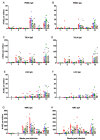Efficacy of Heterologous Prime-Boost Vaccination with H3N2 Influenza Viruses in Pre-Immune Individuals: Studies in the Pig Model
- PMID: 32882956
- PMCID: PMC7552030
- DOI: 10.3390/v12090968
Efficacy of Heterologous Prime-Boost Vaccination with H3N2 Influenza Viruses in Pre-Immune Individuals: Studies in the Pig Model
Abstract
In a previous study in influenza-naïve pigs, heterologous prime-boost vaccination with monovalent, adjuvanted whole inactivated vaccines (WIV) based on the European swine influenza A virus (SwIAV) strain, A/swine/Gent/172/2008 (G08), followed by the US SwIAV strain, A/swine/Pennsylvania/A01076777/2010 (PA10), was shown to induce broadly cross-reactive hemagglutination inhibition (HI) antibodies against 12 out of 15 antigenically distinct H3N2 influenza strains. Here, we used the pig model to examine the efficacy of that particular heterologous prime-boost vaccination regimen, in individuals with pre-existing infection-immunity. Pigs were first inoculated intranasally with the human H3N2 strain, A/Nanchang/933/1995. Seven weeks later, they were vaccinated intramuscularly with G08 followed by PA10 or vice versa. We examined serum antibody responses against the hemagglutinin and neuraminidase, and antibody-secreting cell (ASC) responses in peripheral blood, draining lymph nodes, and nasal mucosa (NMC), in ELISPOT assays. Vaccination induced up to 10-fold higher HI antibody titers than in naïve pigs, with broader cross-reactivity, and protection against challenge with an antigenically distant H3N2 strain. It also boosted ASC responses in lymph nodes and NMC. Our results show that intramuscular administration of WIV can lead to enhanced antibody responses and cross-reactivity in pre-immune subjects, and recall of ASC responses in lymph nodes and NMC.
Keywords: H3N2; antibody cross-reactivity; heterologous prime-boost; humans; influenza; pre-existing immunity; swine; vaccination.
Conflict of interest statement
The authors declare no conflict of interest.
Figures




Similar articles
-
Heterologous prime-boost H1N1 vaccination exacerbates disease following challenge with a mismatched H1N2 influenza virus in the swine model.Front Immunol. 2023 Oct 20;14:1253626. doi: 10.3389/fimmu.2023.1253626. eCollection 2023. Front Immunol. 2023. PMID: 37928521 Free PMC article.
-
Broadly Reactive H2 Hemagglutinin Vaccines Elicit Cross-Reactive Antibodies in Ferrets Preimmune to Seasonal Influenza A Viruses.mSphere. 2021 Mar 10;6(2):e00052-21. doi: 10.1128/mSphere.00052-21. mSphere. 2021. PMID: 33692193 Free PMC article.
-
Alternating 3 different influenza vaccines for swine in Europe for a broader antibody response and protection.Vet Res. 2022 Jun 15;53(1):44. doi: 10.1186/s13567-022-01060-x. Vet Res. 2022. PMID: 35705993 Free PMC article.
-
Does Vaccine-Induced Maternally-Derived Immunity Protect Swine Offspring against Influenza a Viruses? A Systematic Review and Meta-Analysis of Challenge Trials from 1990 to May 2021.Animals (Basel). 2023 Oct 3;13(19):3085. doi: 10.3390/ani13193085. Animals (Basel). 2023. PMID: 37835692 Free PMC article. Review.
-
B Cells and Functional Antibody Responses to Combat Influenza.Front Immunol. 2015 Jun 30;6:336. doi: 10.3389/fimmu.2015.00336. eCollection 2015. Front Immunol. 2015. PMID: 26175732 Free PMC article. Review.
Cited by
-
Heterologous prime-boost H1N1 vaccination exacerbates disease following challenge with a mismatched H1N2 influenza virus in the swine model.Front Immunol. 2023 Oct 20;14:1253626. doi: 10.3389/fimmu.2023.1253626. eCollection 2023. Front Immunol. 2023. PMID: 37928521 Free PMC article.
-
Sequential vaccinations with divergent H1N1 influenza virus strains induce multi-H1 clade neutralizing antibodies in swine.Nat Commun. 2023 Nov 27;14(1):7745. doi: 10.1038/s41467-023-43339-3. Nat Commun. 2023. PMID: 38008801 Free PMC article.
-
Exploring Prime-Boost Vaccination Regimens with Different H1N1 Swine Influenza A Virus Strains and Vaccine Platforms.Vaccines (Basel). 2022 Oct 29;10(11):1826. doi: 10.3390/vaccines10111826. Vaccines (Basel). 2022. PMID: 36366335 Free PMC article.
-
Heterologous Prime-Boost Vaccination with Commercial FMD Vaccines Elicits a Broader Immune Response than Homologous Prime-Boost Vaccination in Pigs.Vaccines (Basel). 2023 Feb 25;11(3):551. doi: 10.3390/vaccines11030551. Vaccines (Basel). 2023. PMID: 36992134 Free PMC article.
-
Respiratory and Intramuscular Immunization With ChAdOx2-NPM1-NA Induces Distinct Immune Responses in H1N1pdm09 Pre-Exposed Pigs.Front Immunol. 2021 Nov 3;12:763912. doi: 10.3389/fimmu.2021.763912. eCollection 2021. Front Immunol. 2021. PMID: 34804053 Free PMC article.
References
-
- Van Reeth K., Vincent A. Influenza viruses. In: Zimmerman J.J., Karriker L.A., Ramirez A., Schwartz K.J., Stevenson G.W., Zhang J., editors. Diseases of Swine. 11th ed. John Wiley & Sons, Incorporated; Hoboken, NJ, USA: 2019. pp. 576–593.
-
- Nelson M.I., Wentworth D.E., Culhane M.R., Vincent A.L., Viboud C., LaPointe M.P., Lin X., Holmes E.C., Detmer S.E. Introductions and evolution of human-origin seasonal influenza a viruses in multinational swine populations. J. Virol. 2014;88:10110–10119. doi: 10.1128/JVI.01080-14. - DOI - PMC - PubMed
-
- Haesebrouck F., Biront P., Pensaert M.B., Leunen J. Epizootics of respiratory tract disease in swine in Belgium due to H3N2 influenza virus and experimental reproduction of disease. Am. J. Vet. Res. 1985;46:1926–1928. - PubMed
-
- de Jong J.C., Smith D.J., Lapedes A.S., Donatelli I., Campitelli L., Barigazzi G., Van Reeth K., Jones T.C., Rimmelzwaan G.F., Osterhaus A.D., et al. Antigenic and genetic evolution of swine influenza A (H3N2) viruses in Europe. J. Virol. 2007;81:4315–4322. doi: 10.1128/JVI.02458-06. - DOI - PMC - PubMed
MeSH terms
Substances
LinkOut - more resources
Full Text Sources
Medical
Miscellaneous

